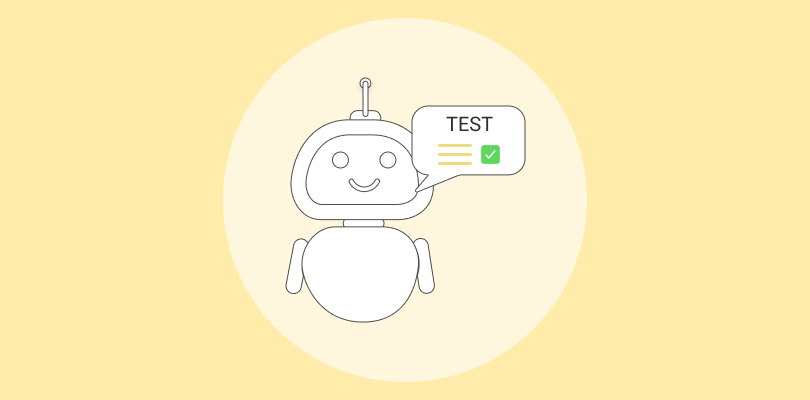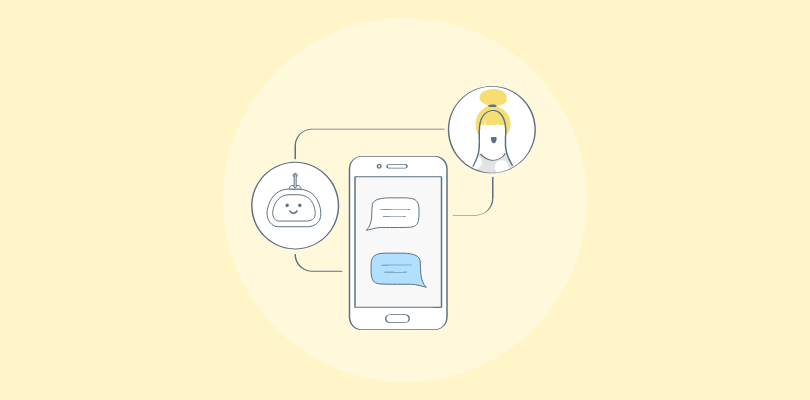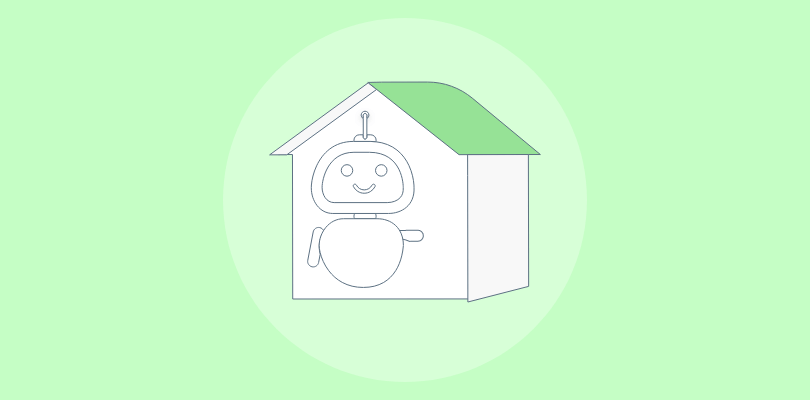While researching, I was surprised to know that 40% of consumers say having multiple ways of communication is the most important aspect of a company’s customer service. That’s a huge jump from just a few years ago, highlighting the growing importance of multichannel chatbots.
As someone who’s witnessed the rise of chatbots for over a decade, I understand their value in providing seamless support across platforms like messaging apps, social media, and even websites.
In this blog, we’ll dive into the world of multichannel chatbots, exploring their benefits and different functionalities and explaining how to implement them effectively.
Let’s get started!
What is a Multichannel Chatbot?
A multichannel chatbot is a digital tool designed to engage with users across multiple platforms, such as websites, social media, messaging apps, and email. It utilizes artificial intelligence to provide consistent, automated responses to user inquiries regardless of the communication channel.
For instance, a business might use a multichannel chatbot to handle customer service queries on Facebook, Twitter, and its own website simultaneously, ensuring a seamless user experience. This approach not only enhances customer satisfaction but also increases operational efficiency.
Companies like Sephora and Domino’s Pizza have successfully implemented multichannel chatbots to boost customer engagement and streamline service operations.
Also Read: What Is Multi-Channel Customer Service and Why It Is Important
How Does Multichannel Chatbot Work?
A multichannel chatbot is designed to interact with users across multiple platforms or communication channels, such as websites, mobile apps, social media platforms, and messaging apps.
The core principle behind a multichannel chatbot is to provide a consistent and unified user experience, regardless of the channel through which a user chooses to interact.
Here’s a breakdown of how multichannel chatbots typically work:
1. Centralized Processing and Management:
- Core Engine: At the heart of a multichannel chatbot is the chatbot engine that processes user inputs, understands the context, and generates appropriate responses. This engine often leverages natural language processing (NLP) and machine learning to improve its understanding and responses over time.
- Integration Layer: This layer connects the core engine to various channels. It ensures that messages from different platforms are formatted and processed in a way that the core engine can understand.
2. Channel-Specific Adapters:
Each channel (like Facebook Messenger, WhatsApp, or a web-based chat widget) may have its unique features and limitations. Channel-specific adapters or connectors help translate the chatbot’s functionalities into actions that are compatible with each platform. For instance, a chat widget on a website might support rich media like images and buttons, whereas SMS-based interactions are text-only.
3. Unified User Experience:
The chatbot aims to provide a consistent experience across all channels. This means maintaining the continuity of conversations and user preferences. If a user switches from a social media message to a chat on a company’s website, the chatbot should be able to recognize the user and continue the conversation seamlessly.
4. Data Handling and Security:
Handling user data securely and maintaining privacy across multiple channels is crucial. The chatbot system needs to comply with data protection regulations such as GDPR or HIPAA, depending on the nature of the data and the geographic location of the users.
5. Analytics and Optimization:
Multichannel chatbots often come with analytics capabilities to track interactions across different platforms. This data helps in understanding user behavior and preferences, which in turn assists in optimizing the chatbot’s responses and functionalities.
6. Development and Maintenance:
Developing a multichannel chatbot requires a robust framework that supports integration with multiple platforms and can scale as new channels are added. Continuous testing and updates are necessary to adapt to changes in platforms and user expectations.
So, multichannel chatbots deliver the right information to users on their preferred platform seamlessly and efficiently. They use advanced technologies to ensure smooth interaction regardless of the communication medium.
How Multichannel Chatbots Improve Customer Experience
Multichannel chatbots significantly enhance customer experience by providing seamless, consistent service across various communication platforms such as email, social media, and websites.
For instance, a study report highlights that 64% of consumers expect real-time interactions and responses, which multichannel bots efficiently deliver by being available 24/7, reducing wait times, and increasing customer satisfaction.
Besides, these bots can gather data from interactions across all channels to deliver more personalized experiences.
For example, KLM Royal Dutch Airlines implemented a chatbot that handles over 16,000 weekly interactions across WhatsApp, Facebook Messenger, and Twitter, providing tailored travel information that greatly enhances customer satisfaction and loyalty.
By offering consistent and personalized service, multichannel chatbots play a crucial role in improving customer engagement and operational efficiency.
Also Read: 10 Best Customer Service Channels to Improve Your Customer Experience
What are the Features of Multichannel Chatbot?
Multichannel chatbots have several distinctive features that enable them to operate across various communication platforms effectively.
Here are some of the key multichannel chatbot features:
- Platform Integration: Multichannel chatbots are designed to seamlessly integrate with multiple messaging platforms such as SMS, email, social media channels (like Facebook Messenger, WhatsApp), and websites. This allows them to engage with users on their preferred platforms without needing to switch contexts.
- Automated Routing: Multichannel chatbots can automatically route queries to the appropriate channel based on user preferences, availability, or the nature of the inquiry. This routing ensures that the user is always interacting through the most suitable medium.
- Automated Greetings: The chatbots use automated greetings to promptly welcome users, making them feel acknowledged and valued. This feature ensures a positive first impression and sets a friendly tone for the conversation, enhancing customer engagement and satisfaction.
- Canned Response: Chatbots utilize canned responses to quickly address common inquiries. These pre-written answers ensure consistency, accuracy, and efficiency, reducing response time and improving the overall user experience by providing quick solutions.
- Proactive Chat Invitation: By offering proactive chat invitations, chatbots engage visitors before they seek help, identifying and addressing potential issues early. This proactive approach increases customer satisfaction and conversion rates by providing timely assistance.
- Chat Customization: Customization allows chatbots to tailor interactions based on user preferences and behavior. Personalized responses and recommendations enhance relevance and engagement, leading to a more satisfying and efficient user experience.
- Chat Transcripts: Chat transcripts provide a record of conversations for both users and support teams. They facilitate follow-up, ensure continuity, and help in analyzing customer interactions to improve service quality and training.
- Mobile Compatibility: Ensuring mobile compatibility allows chatbots to offer seamless service across devices. Users can access support conveniently from their smartphones, enhancing accessibility and user experience by providing help on the go.
- Analytics and Reporting: They often come with sophisticated analytics and reporting capabilities that aggregate data across all channels. This provides comprehensive insights into user behaviors, preferences, and engagement patterns.
- Natural Language Processing (NLP): Advanced multichannel chatbots utilize NLP to understand better and respond to user queries more humanistically across all channels.
These features are crucial for ensuring that multichannel chatbots function efficiently and meet the diverse needs of modern communication landscapes.
Read: 12 Essential Chatbot Features to Consider in 2025
FREE. All Features. FOREVER!
Try our Forever FREE account with all premium features!
What are the Benefits of Multichannel Chatbot?
Multichannel chatbots, which can operate across various platforms like social media, websites, messaging apps, and more, offer several benefits for businesses and users alike.
Here are some of their key multichannel chatbot benefits:
- You Get a Far-and-Wide Reach:
Multichannel chatbots can engage customers on various platforms where they spend their time. This helps businesses reach a wider audience by being present on multiple channels like Facebook Messenger, WhatsApp, email, SMS, and more.
- You Can Deliver Consistent Experiences:
Having a chatbot available on multiple channels ensures that the business can offer a consistent experience to its customers, no matter where they choose to interact. This helps to maintain a uniform brand voice and customer service quality.
- There’s Engagement Across Channels:
By being available on the platforms that customers use daily, multichannel chatbots enhance engagement. They provide quick answers to questions, assist in navigation, and facilitate easier transactions, making customer interaction more seamless and efficient.
- 24/7 Service That Never Sleeps:
Chatbots can operate around the clock, providing answers and support to customers at any time. This is particularly valuable for global businesses that deal with customers across different time zones.
- Better Decisions with Data Insights:
Multichannel chatbots can gather data from different platforms, giving businesses valuable insights into customer preferences and behaviors. This data can be used to improve products and services, tailor marketing strategies, and enhance overall customer satisfaction.
- Reduced Operational Costs:
Automating customer service tasks across various channels can significantly reduce operational costs. Chatbots can handle numerous customer interactions simultaneously, reducing the need for a large customer service team.
- You Experience Seamless Growth:
As the business grows, chatbots can easily scale to handle increased traffic across channels without a corresponding increase in support staff. This makes them a sustainable option for growing customer bases.
- Higher Conversions:
By providing immediate assistance and support, chatbots can help guide a customer through the purchase process, leading to improved conversion rates. They can answer product questions, recommend products, and even handle transactions directly through the chat interface.
No wonder multichannel chatbots are a powerful tool for enhancing customer interaction, streamlining service delivery, and improving operational efficiencies across different digital touchpoints.
Read Now: Top 10 Free AI Chatbot Software in 2025 [With Pros & Cons]
Future Trends in Multichannel Chatbots
The future trends in multichannel chatbots point towards several exciting developments as businesses seek to enhance customer experience and streamline communication across various platforms. Here are some key trends likely to shape the evolution of multichannel chatbots:
- Omnichannel Integration: Future chatbots are expected to seamlessly integrate across multiple channels like messaging apps, social media, and corporate websites. This omnichannel approach will provide a unified customer experience, ensuring that interactions are synced and consistent across all platforms.
- Advanced Natural Language Processing (NLP): As NLP technology evolves, chatbots will become more adept at understanding and responding to complex queries. This includes better context handling, emotional recognition, and the ability to manage nuanced conversations, making interactions more natural and engaging.
- Predictive Analytics: Using AI and machine learning algorithms, chatbots will be able to predict customer needs and provide proactive support. This includes anticipating questions, offering timely suggestions, and personalizing interactions based on customer data and past behavior.
- Voice Technology Integration: Voice-enabled chatbots will become more prevalent across various platforms, including mobile apps and home assistants. This trend will be driven by the increasing popularity of voice-based interfaces and the convenience they offer for hands-free operation.
- Increased Security and Privacy: With growing concerns about data privacy, future chatbots will incorporate more robust security measures to protect user information. This includes end-to-end encryption and adherence to international data protection regulations.
- Enhanced Visual Capabilities: Integration of visual tools like augmented reality (AR) and rich media (videos, images, interactive elements) into chatbots will enhance user interaction. These features will be particularly useful in sectors like retail, real estate, and education.
- Interoperability and Standards: As the deployment of chatbots expands, there will be a greater emphasis on developing standards and protocols for interoperability. This will ensure that chatbots can interact with each other and with different systems, making it easier to manage cross-platform integrations.
- Chatbots as Brand Ambassadors: Companies will increasingly use chatbots for customer service and branding. Chatbots will embody brand values and play key roles in marketing campaigns, engaging users with personalized content.
These trends indicate that multichannel chatbots are set to become more integrated, intelligent, and indispensable tools in customer interaction strategies.
This evolution will be driven by advancements in AI, machine learning, and cross-platform technologies, promising a future where chatbots are central to digital communication strategies.
Also Read: The Future of Live Chat - Rise of Chatbots
Case Studies
- The Elias Music Case
| Here’s how ELIAS, a full-service music and audio agency founded by Grammy-nominated composer, producer, and musician Jonathan Elias, used ProProfs Chat to stay available 24×7 in order to help listeners and fans in real-time.Read Complete Story |
- The Lazy Cloud Lodge Case
| Here’s how Lazy Cloud Lodge, comprising of Lazy Cloud Bed and Breakfast and Lazy Cloud Inn, used ProProfs Chat to communicate with potential guests using Canned Response Feature, saving a lot of their time. |
Meet Customers Where They Are with Multichannel Chatbots
In an increasingly digital world, the importance of efficient, responsive communication has never been more pronounced. Multichannel chatbots represent a significant leap forward in seamlessly meeting customer expectations across various platforms.
They offer the agility and flexibility required to adapt to diverse communication needs, ensuring businesses remain at the forefront of customer service and engagement. This is why multichannel chatbots are not just a trend but the future of digital interaction.
For businesses looking to implement these solutions, ProProfs Chat is an excellent tool. It simplifies the creation of sophisticated multichannel, effective, and user-friendly chatbots, making it an ideal choice for enhancing customer interaction.
 Tips
Tips
We’d love to hear your tips & suggestions on this article!
FREE. All Features. FOREVER!
Try our Forever FREE account with all premium features!


 We'd love your feedback!
We'd love your feedback! Thanks for your feedback!
Thanks for your feedback!







